the first, let us propose that we discoverthat microbial life from Earth has alreadyreached Mars, having arrived there atsome time in the distant past by some sortof panspermia process. The possibilitythat bacteria could make such a journeyacross space was first proposed byArrhenius 38 a century ago and has beenrevived in a different guise recently whenit was realised that planets exchangepieces of themselves following impactsenergetic enough to propel debris intospace. Bacteria living in the middle of anejecta fragment might be sufficientlyshielded from heat shock and radiation tosurvive the many years in transit and thefinal trauma of touchdown onto the newworld 39 . Would this discovery be morallycriticised by preservationists? Might theyconsider that founding colony of microbesto have been violators of Mars? Mightthey regard its descendants, the extantpopulation, to be a form of immoralpollution? Of course not. Bacteria cannotbe praised or blamed for being in the rightplace or the wrong place at the right time.The discovery would be regarded as aparticularly noteworthy event in thehistory of life, but one undeserving ofmoral censure. Even the most hard-line ofpreservationists would concede thecontaminating event as a natural event.Arriving on a meteorite, those pioneermicrobes no more polluted Mars than thefirst living cell polluted the Earth.In our second scenario however, it ishumans who take life to Mars, who alterthe climate of the planet so it can support athriving ecosystem. We terraform Mars.Now there is an obvious ethical dimension:would it be right or wrong for us to dothis? Perhaps in the light of scenario onethough, the question can be rephrased. Ifthe unconscious diversification of life isnot a moral issue from the standpoint ofMars, why is it that intentionaldiversification be subject to moralscrutiny? The reason is that only humansare subject to moral praise or blame. It isour own values that are at issue, notfictional ones ascribed to unconscious ornon-living entities. They are the onlyvalues we can know to be real and the onlyones that can motivate both action andrestraint.It is thus the conscious enactment ofchange that preservationists most objectto, in the same manner that ecocentristsobject to it on Earth. But is there anythingfundamentally unnatural or wickedinherent in this ability? No. Whilst we areright to regard the Universe, with all itsprojects, from the vast to the microscopic,with wonder and a degree of humility, theUniverse does seem to be a reasonableplace. It seems to be showing us that it iscomprehensible, if not all comprehended.It is subject to cause and effect, to freewill. Reason therefore, as suggested byPlato and Kant, has a transcendent andautonomous nature. It can be projected aswell as contained within the self. Itsprovince is the Universe at large. Reasoncan enact intentional change. It canlegitimately stand against what is, forideals of what ought to be. Humanconsciousness, culture, creativity—and thetechnological artefacts produced thereby—are thus not unnatural. They have arisenfrom the same physics that gave birth tothe cosmos and the same process ofbiological evolution that followed thegenesis of the first living cell. They are asnatural as sex, photosynthesis, aerobicrespiration, and a host of other biologicalprocesses, all of which were inventedsome considerable time after life’s originand all of which changed the Earthdrastically and forever.Would Mars be a better place transformedinto a living world? Preservationismwould say no, but its movement from whatis descriptively true of Mars to aprescriptive claim is arbitrary andunconvincing. The argument amounts tosaying that humans actually have thelowest degree of intrinsic worth of anyclass of formed object. Rocks are free torust and crumble over the aeons, asteroidsand meteorites free to batter the Martiansurface, and microbes free to hitch a ride ifthey can survive the trip and there toevolve in to new forms that are Martian.Only humans should be constrained fromfulfilling their evolutionary potentialaccording to this philosophy. Yet if space-8
faring is a legitimate activity for microbes,why should it not be so for humans? Theallied ideologies of misanthropy andsentimentality cannot provide asatisfactory answer.There is no fundamental moral objectionto bringing life to Mars as opposed to itoriginating there, or arriving there byaccident. If life begins on Mars during theplanet’s middle age, as opposed to itsyouth, then this is more an issue of timingthan of morality. Life might change Marsbut it will not detract from the planet’suniqueness. This is not to say that there areno moral issues inherent in spacesettlement—there will still be right andwrong ways to go about it—but we willhave to appeal to our own values in orderto resolve them.References1. National Commission on Space,Pioneering the Space Frontier,Bantam Books, New York, 1986.2. J. Lewis, et al. (Eds.), Resources ofNear Earth Space, University ofArizona Press, Tucson, 1993.3. G.K. O’Neill, The High Frontier,Corgi Books, London, 1978.4. R.D. Johnson and C. Holbrow (Eds.),Space Settlements—A Design Study,NASA SP-413, 1977.5. P.J. Boston (Ed.), The Case for Mars,AAS Science and Technology Series,Vol. 57, 1984.6. C.P. McKay (Ed.), The Case for MarsII, AAS Science and TechnologySeries, Vol. 62, 1985.7. C.R. Stoker (Ed.), The Case for MarsIII, AAS Science and TechnologySeries, Vol. 74-75, 1989.8. Y Ishikawa, T. Ohkita and Y.Amemiya, “Mars Habitation 2057:Concept Design of a Mars Settlementin the Year 2057.” JBIS, 43, 505-512,1990.9. R.M. Zubrin and R. Wagner, The Casefor Mars: The Plan to Settle the RedPlanet and Why We Must, The FreePress, New York, 1996.10. R.M. Zubrin (Ed.), From Imaginationto Reality: Mars Exploration Studiesof the Journal of the BritishInterplanetary Society, AAS Scienceand Technology Series, Vol. 91-92,1997.11. O. Stapledon, Last and First Men,Methuen, London, 1930.12. W. Stewart, “Collision Orbit.”Astounding Science Fiction, XXIX(5),80-117, 1942.13. C.Sagan, “The Planet Venus.”Science, 133, 849-858, 1961.14. M.M. Averner and R.D. MacElroy, Onthe Habitability of Mars: An Approachto Planetary Ecosynthesis, NASA SP-414, 1976.15. C.P. McKay, O.B. Toon, and J.F.Kasting, “Making Mars Habitable,”Nature, 352, 489-496, 1991.16. M.J. Fogg, Terraforming: EngineeringPlanetary Environments, SAEInternational, Warrendale, PA, 1995.17. S.J. Armstrong and R.G. Botzler.Environmental Ethics: Divergenceand Convergence, McGraw-Hill Inc.,1993.18. E.C. Hargrove (Ed.), BeyondSpaceship Earth: EnvironmentalEthics and the Solar System, SierraClub Books, San Francisco, CA, 1986.19. R.H. Haynes, “Ecce Ecopoiesis:Playing God on Mars,” in D.MacNiven (Ed.), Moral Expertise, pp.161-183, Routledge, New York, 1990.20. C.P. McKay, “Does Mars HaveRights? An Approach to theEnvironmental Ethics of PlanetaryEngineering,” in D. MacNiven (Ed.),Moral Expertise, pp. 184-197,Routledge, New York, 1990.21. F. Turner, “The Invented Landscape,”in A.D. Baldwin et al. (Eds.), BeyondPreservation: Restoring and InventingLandscapes, pp. 35-66, University ofMinnesota Press, Minneapolis, 1994.22. D. MacNiven, “Environmental Ethicsand Planetary Engineering,” JBIS, 48,441-443, 1995.23. W.H. Murdy, “Anthropocentrism: AModern Version.” Science, 187, 1168-1172, 1975.24. S.J. Gould, “The Golden Rule—AProper Scale for Our EnvironmentalCrisis.” Natural History, Sept, 24-30,1990.9


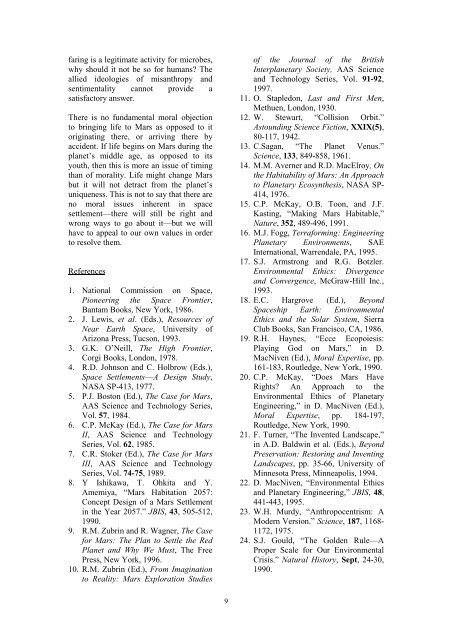
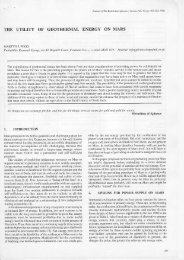
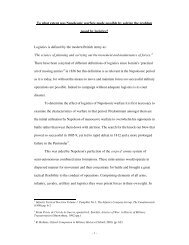


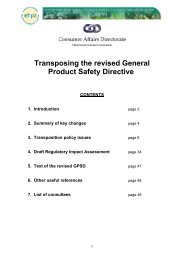
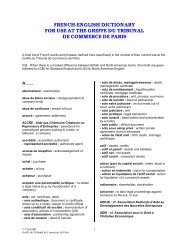

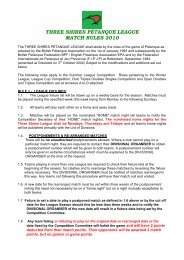
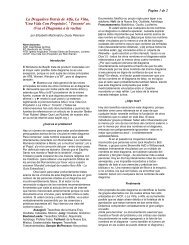

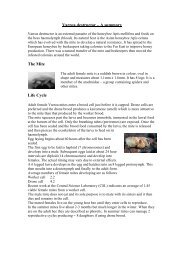

![Tibetan Herbal Medicine Core Curriculum [PDF]](https://img.yumpu.com/32594566/1/184x260/tibetan-herbal-medicine-core-curriculum-pdf.jpg?quality=85)
